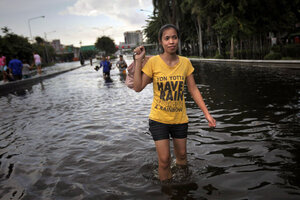Bangkok awaits flood as northern suburbs suffer
Although it remains unclear how much of Bangkok will be flooded, people displaced by the flood in the northern suburbs try to balance keeping themselves safe with protecting their homes.

A Thai woman wades through floodwaters in Bangkok, Thailand, on Oct. 28. The main river coursing through Thailand's capital swelled to record highs Friday, briefly flooding riverside buildings and an ornate royal complex at high tide amid fears that flood defenses could break and swamp the heart of the city.
Altaf Qadri/AP
Bangkok, Thailand
After her house in the northern Bangkok suburb of Nonthaburi was flooded to waist height a week ago, Kanokkorn Nomruen evacuated to Bangkok's Don Muang airport before being moved again to Rajamangala soccer stadium closer to the center of Bangkok.
“I think it might take four weeks for the water to go down at my home,” she said, sitting on a plastic mattress in a sports building close to the stadium where she and almost 2,000 other homeless Thais are sheltering.
“They are looking after us well here,” she smiled. “The worst part is being away from my daughter, who is a receptionist at Lualak hospital. She is sleeping there for now.”
Don Muang airport is closed, and, after being used as a temporary shelter for the flood-displaced, was today itself almost completely flooded, as a slow-moving mass of floodwater to the north of Thailand's capital edges its way towards the center of Bangkok.
The airport is about 14 miles from the business and shopping heart of the city, which otherwise remains dry, with sandbag barriers lining plush shopfronts. How much of inner Bangkok eventually comes under water is still not clear. Earlier Friday morning, a barrier was breached in the Phra Khanong district along one of the inner city's many canals – and potential flood breaking points – that link into the Chao Praya river, which arcs and swerves through Bangkok.
Under pressure from a high tide in the Gulf of Thailand and the mass of floodwater to the north of Bangkok, the river itself has bursts its banks several times in recent days, sending water into riverside temples and residential areas close to where Thailand's elderly king, Bhumibol Adulyadej, is currently hospitalized.
Later on Friday afternoon, I visited the flood-stricken Pathum Thani suburb, north of Don Muang. Edging slowly on a truck through four miles of waist-high blackwater floods – with the stagnant waters now sitting a week in what are normally thronged, bustling streets – the driver, named Lek, said that he doesn't understand why people remain.
Lek, who preferred not to give his full name, is happy to help, however, and explains that “my company is called Siiribut, we usually truck sand,” as we drive past the now-inundated office on Lam Luk Wa road in Pathum Thani. "The boss said we should now use the trucks to help people."
Asked about the water levels in that stricken area, he said that it had dropped by “around six or seven centimeters since yesterday." So, the much-dreaded flood run-off into central Bangkok, if it happens, looks like it will be a slow cascade. It remains unclear how much water can drain, and how quickly, via the Chao Praya river and the network of canals through and around the city, into the Gulf of Thailand.
For the last two days, Lek has driven the sand-truck, with four-foot-high wheels, back and forth on the road, ferrying locals from one dry end to the other, with would-be passengers waving from embankments to call the driver over to stop.
The water stinks, with refuse floating everywhere, so it is not hard to see why Lek would be puzzled why people stay. An answer came, however, after he dropped me, along with 23 other passengers, off at a temporary bus stop to Bangkok's Mo Chit station, the main terminal connecting the city to Thailand's north.
Getting off the bus from Mo Chit and looking up as the skies opened and another untimely, thunderous downpour emptied onto Bangkok, Sirichai Aphawansat said, “I go back home (to Pathum Thani) every evening as I am afraid people will steal.”
